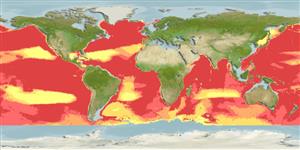>
Lophiiformes (Anglerfishes) >
Ceratiidae (Warty Seadevils)
Etymology: Ceratias: Greek, keras = horn or horned, refers to the lure projecting from the snout (Ref. 86949).
Environment: milieu / climate zone / depth range / distribution range
Ökologie
seewasser bathypelagisch; tiefenbereich 400 - 4400 m (Ref. 74511), usually 400 - 2000 m (Ref. 37729). Deep-water; 67°N - 45°S, 180°W - 180°E
Circumglobal: In tropical to temperate waters. Adults (expatriates ?) found in boreal and subarctic waters. South China Sea and East China Sea (Ref.74511).
Size / Gewicht / Alter
Maturity: Lm ? range ? - ? cm
Max length : 16.0 cm SL Männchen/unbestimmt; (Ref. 7463); 120.0 cm TL (female); common length :77 cm TL (female)
Rückenflossenstacheln (insgesamt): 1; Rückenflossenweichstrahlen (insgesamt): 3-4; Afterflossenstacheln 0; Afterflossenweichstrahlen: 4; Wirbelzahl: 20. Branchiostegal rays: 6 (Ref. 36494).
Maximum size observed for free living males is 1.3 cm (Ref. 10524). Males are parasitic, females oviparous with planktonic larvae (Ref. 36494). Eggs are presumably contained in floating gelatinous rafts (Ref. 36494). Minimum depth from Ref. 037729.
Life cycle and mating behavior
Geschlechtsreife | Fortpflanzung | Ablaichen | Eier | Fecundity | Larven
Bertelsen, E., 1990. Ceratiidae. p. 510-512. In J.C. Quero, J.C. Hureau, C. Karrer, A. Post and L. Saldanha (eds.) Check-list of the fishes of the eastern tropical Atlantic (CLOFETA). JNICT, Lisbon; SEI, Paris; and UNESCO, Paris. Vol. 1. (Ref. 4494)
IUCN Rote Liste Status (Ref. 130435)
Bedrohung für Menschen
Harmless
Nutzung durch Menschen
Fischereien: nicht kommerziell
Mehr Information
ReferenzenAquakulturAquakultur ProfilZuchtlinienGenetikElectrophoresesVererbbarkeitKrankheitenVerarbeitungNutrientsMass conversion
PartnerBilderStamps, Coins Misc.LauteCiguateraGeschwindigkeitSchwimmstilKiemenoberflächeOtolithsGehirngrößeSehfähigkeit
Tools
Zusatzinformationen
Download XML
Internet Quellen
Estimates based on models
Preferred temperature (Ref.
123201): 2 - 9.7, mean 3.8 °C (based on 7133 cells).
Phylogenetic diversity index (Ref.
82804): PD
50 = 0.6875 [Uniqueness, from 0.5 = low to 2.0 = high].
Bayesian length-weight: a=0.01995 (0.00906 - 0.04395), b=3.01 (2.83 - 3.19), in cm total length, based on all LWR estimates for this body shape (Ref.
93245).
Trophic level (Ref.
69278): 3.2 ±0.40 se; based on food items.
Fishing Vulnerability (Ref.
59153): High to very high vulnerability (72 of 100).
